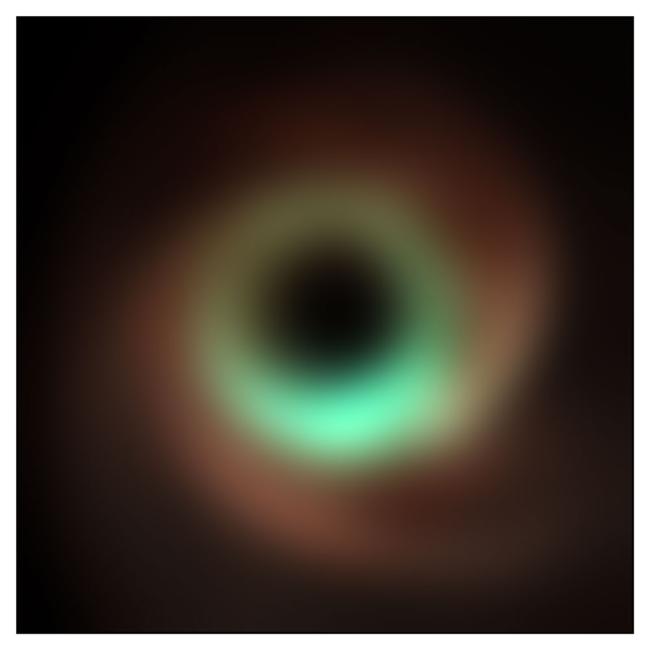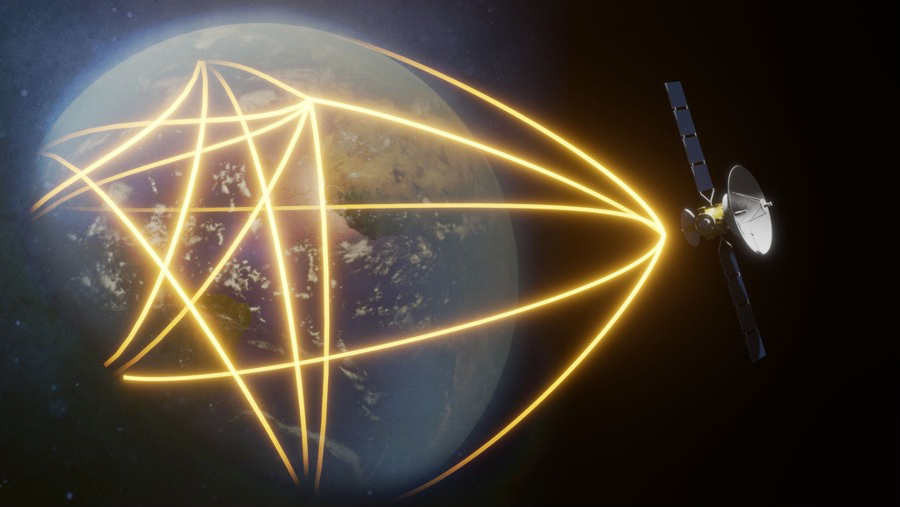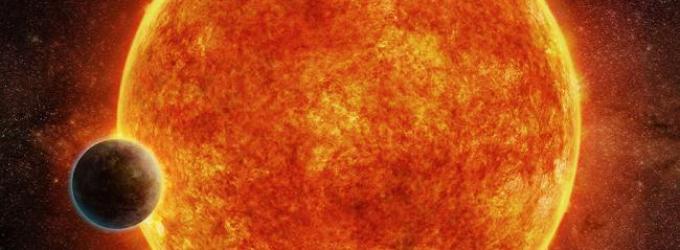Overview
Since 2018, I have been working with scientists around the world from the Event Horizon Telescope (EHT) Collaboration, including founding director Shep Doeleman. Shep contacted me in July 2024 for help with a press release, not for the CfA scientists in the collaboration, but for the overall collaboration. I worked with more than 20 individuals and press officers to ensure that this release captured the right story surrounding their work, and to ensure that the images told a story all their own.
Highlighted Placements
Newsweek, “Sharpest New Images of Black Holes ‘Will Likely Reveal New Properties’,” August 28, 2024
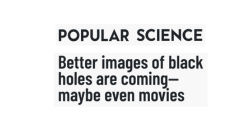
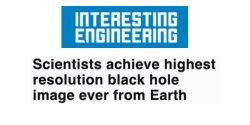
Press Release
View full press release and assets at cfa.harvard.edu
Event Horizon Telescope Makes Highest-Resolution Black Hole Detections from Earth
Using the Event Horizon Telescope (EHT), astronomers have achieved very-long-baseline interferometry test observations at 345 GHz, the highest-resolution such observations ever obtained from the surface of Earth. Scientists estimate that the breakthrough will result in a remarkable 50% increase in detail, sharpening images and observations of black holes and their surrounding regions.
The Event Horizon Telescope (EHT) Collaboration has conducted test observations achieving the highest resolution ever obtained from the surface of the Earth, by detecting light from the centers of distant galaxies at a frequency of around 345 GHz.
When combined with existing images of supermassive black holes at the hearts of M87 and Sgr A at the lower frequency of 230 GHz, these new results will not only make black hole photographs 50% crisper but also produce multi-color views of the region immediately outside the boundary of these cosmic beasts.
The new detections, led by scientists from the Center for Astrophysics | Harvard & Smithsonian (CfA) that includes the Smithsonian Astrophysical Observatory (SAO), were published today in The Astronomical Journal.
“With the EHT, we saw the first images of black holes by detecting radio waves at 230 GHz, but the bright ring we saw, formed by light bending in the black hole’s gravity still looked blurry because we were at the absolute limits of how sharp we could make the images,” said paper co-lead Alexander Raymond, previously a postdoctoral scholar at the CfA, and now at NASA’s Jet Propulsion Laboratory (NASA-JPL). “At 345 GHz, our images will be sharper and more detailed, which in turn will likely reveal new properties, both those that were previously predicted and maybe some that weren’t.”
The EHT creates a virtual Earth-sized telescope by linking together multiple radio dishes across the globe, using a technique called very-long-baseline interferometry (VLBI). To get higher-resolution images, astronomers have two options: increase the distance between radio dishes or observe at a higher frequency. Since the EHT was already the size of our planet, increasing the resolution of ground-based observations required expanding its frequency range, and that’s what the EHT Collaboration has now done.
“To understand why this is a breakthrough, consider the burst of extra detail you get when going from black and white photos to color,” said paper co-lead Sheperd “Shep” Doeleman, an astrophysicist at the CfA and SAO, and Founding Director of the EHT. “This new ‘color vision’ allows us to tease apart the effects of Einstein’s gravity from the hot gas and magnetic fields that feed the black holes and launch powerful jets that stream over galactic distances.”
A prism splits white light into a rainbow of colors because different wavelengths of light travel at different speeds through glass. But gravity bends all light similarly, so Einstein predicts that the size of the rings seen by the EHT should be similar at both 230 GHz and 345 GHz, while the hot gas swirling around the black holes will look different at these two frequencies.
This is the first time the VLBI technique has been successfully used at a frequency of 345 GHz. While the ability to observe the night sky with single telescopes at 345 GHz existed before, using the VLBI technique at this frequency has long presented challenges that took time and technological advances to overcome. Water vapor in the atmosphere absorbs waves at 345 GHz much more than at 230 GHz weakening the signals from black holes at the higher frequency. The key was to improve the sensitivity of the EHT, which the researchers did by increasing the bandwidth of the instrumentation and waiting for good weather at all sites.
The new experiment used two small subarrays of the EHT—made up of the Atacama Large Millimeter/submillimeter Array (ALMA) and the Atacama Pathfinder EXperiment (APEX) in Chile, the IRAM 30-meter telescope in Spain, the NOrthern Extended Millimeter Array (NOEMA) in France, the Submillimeter Array (SMA) on Maunakea in Hawai’i, and the Greenland Telescope—to make measurements with resolution as fine as 19 microarcseconds.
“The most powerful observing locations on Earth exist at high altitudes, where atmospheric transparency and stability is optimal but weather can be more dramatic,” said Nimesh Patel, an astrophysicist at the CfA and SAO, and a project engineer at SMA, adding that at the SMA, the new observations required braving icy roads at Maunakea to open the array in the stable weather after a snow storm with minutes to spare. “Now, with high-bandwidth systems that process and capture wider swaths of the radio spectrum, we are starting to overcome basic problems in sensitivity, like weather. The time is right, as the new detections prove, to advance to 345 GHz.”
This achievement also provides another stepping stone on the path to creating high-fidelity movies of the event horizon environment surrounding black holes, which will rely on upgrades to the existing global array. The planned next-generation EHT (ngEHT) project will add new antennas to the EHT in optimized geographical locations and enhance existing stations by upgrading them all to work at multiple frequencies between 100 GHz and 345 GHz at the same time. As a result of these and other upgrades, the global array is expected to increase the amount of sharp, clear data EHT has for imaging by a factor of 10, enabling scientists to not only produce more detailed and sensitive images but also movies starring these violent cosmic beasts.
“The EHT’s successful observation at 345 GHz is a major scientific milestone,” said Lisa Kewley, Director of CfA and SAO. “By pushing the limits of resolution, we’re achieving the unprecedented clarity in the imaging of black holes we promised early on, and setting new and higher standards for the capability of ground-based astrophysical research.”
Resource
“First Very Long Baseline Interferometry Detections at 870 μm,” A.W. Raymond, S. Doeleman, et al (2024), The Astronomical Journal, DOI: 10.3847/1538-3881/ad5bdb.
About the Submillimeter Array (SMA)
The Submillimeter Array is a joint project of the Smithsonian Astrophysical Observatory and the Academia Sinica Institute of Astronomy and Astrophysics. We acknowledge the significance that Maunakea, where the SMA is located, has for the indigenous Hawaiian people.
About the Greenland Telescope
The Greenland Telescope is a joint project of the Smithsonian Astrophysical Observatory and the Academica Sinica Institute of Astronomy and Astrophysics.
About EHT
The EHT Collaboration involves more than 400 researchers from Africa, Asia, Europe, North and South America, with around 270 participating in this paper. The international collaboration aims to capture the most detailed black hole images ever obtained by creating a virtual Earth-sized telescope. Supported by considerable international efforts, the EHT links existing telescopes using novel techniques—creating a fundamentally new instrument with the highest angular resolving power that has yet been achieved.
The EHT consortium consists of 13 stakeholder institutes; the Academia Sinica Institute of Astronomy and Astrophysics, the University of Arizona, the Center for Astrophysics | Harvard & Smithsonian including the Smithsonian Astrophysical Observatory, the University of Chicago, the East Asian Observatory, Goethe University Frankfurt, Institut de Radioastronomie Millimétrique, Large Millimeter Telescope, Max Planck Institute for Radio Astronomy, MIT Haystack Observatory, National Astronomical Observatory of Japan, Perimeter Institute for Theoretical Physics, and Radboud University.
About the Center for Astrophysics | Harvard & Smithsonian
The Center for Astrophysics | Harvard & Smithsonian is a collaboration between Harvard and the Smithsonian designed to ask—and ultimately answer—humanity’s greatest unresolved questions about the nature of the universe. The Center for Astrophysics is headquartered in Cambridge, MA, with research facilities across the U.S. and around the world.
Media Contact
Amy Oliver
Public Affairs Officer, Whipple Observatory
Center for Astrophysics | Harvard & Smithsonian
+1-520-879-4406
amy.oliver@cfa.harvard.edu
